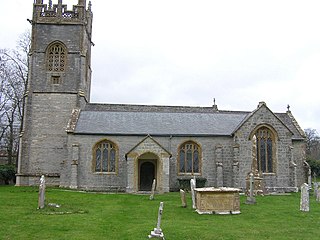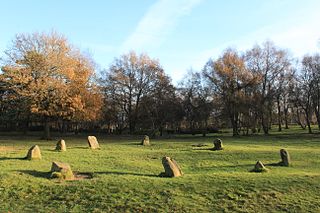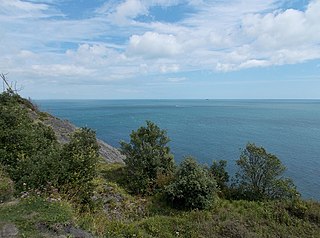
Clovis points are the characteristically-fluted projectile points associated with the New World Clovis culture. They are present in dense concentrations across much of North America; in South America, they are largely restricted to the north of that continent. Clovis points date to the Early Paleoindian period roughly 13,500 to 12,800 calendar years ago. Clovis fluted points are named after the city of Clovis, New Mexico, where examples were first found in 1929 by Ridgely Whiteman.

Hatch Beauchamp is a village and civil parish in Somerset, England, situated 5 miles (8.0 km) south east of Taunton in the Taunton Deane district. The village has a population of 620.

Nine Ladies is a Bronze Age stone circle located on Stanton Moor, Derbyshire, England. Part of the Peak District National Park, the site is owned by English Heritage and is often visited by tourists and hill walkers. Druids and pagans occasionally celebrate summer solstice there.
Sir Thomas Munro Gault was a New Zealand jurist. He was a Justice of the Supreme Court of New Zealand and a member of the Privy Council of the United Kingdom as well as a non-permanent judge of the Court of Final Appeal in Hong Kong. He was also a justice of the Supreme Court of Fiji.

Lambert's Castle is an Iron Age hill fort in the county of Dorset in southwest England. Since 1981 it has been designated as a Site of Special Scientific Interest (SSSI) on account of its geology, archaeology and ecology.
In re Gault, 387 U.S. 1 (1967), was a landmark U.S. Supreme Court decision in which the Primary Holding was that the Due Process Clause of the 14th Amendment applies to juvenile defendants as well as to adult defendants. Juveniles accused of crimes in a delinquency proceeding must be afforded many of the same due process rights as adults, such as the right to timely notification of the charges, the right to confront witnesses, the right against self-incrimination, and the right to counsel. The court's opinion was written by Justice Abe Fortas, a noted proponent of children's rights.

Llys Rhosyr is an archaeological site near Newborough in Anglesey; the ruins of a pre-Edwardian commotal court.

Brigadier General Andrew Hamilton Gault was a Canadian Army officer and British politician. At his own expense, he raised the Princess Patricia's Canadian Light Infantry, the last privately raised regiment in the British Empire. Hatch Court in Somerset today houses a small museum commemorating Gault's military career. From 1924 to 1935 he was the Conservative Member of Parliament for Taunton, Somerset. Returning to Quebec after World War II, Gault vigilantly defended his estate of Mont Saint-Hilaire from expropriation by mining interests and bequeathed it to McGill University to help ensure its preservation.

The Wood Street Compter was a small prison within the City of London in England. It was primarily a debtors' prison, and also held people accused of such misdemeanours as public drunkenness, although some wealthier prisoners were able to obtain alcohol through bribery. The prison was built and opened in 1555, replacing the earlier Bread Street Compter, from which many prisoners were transferred.

Bonchurch Landslips is a 28.2 hectare site of special scientific interest which is located north-east of Ventnor, Isle of Wight. A wooded coastal landslip zone, the site was notified in 1977 for both its biological and geological features.

Titsey Woods is a 45.3-hectare (112-acre) biological Site of Special Scientific Interest north-west of Oxted in Surrey.

Roswell Pits is an 8 hectare nature reserve on the eastern outskirts of Ely in Cambridgeshire. It is managed by the Environment Agency. It is part of the Ely Pits and Meadows Site of Special Scientific Interest (SSSI)) and Geological Conservation Review site. The SSSI designation for both biological and geological interest. The site was formerly managed by the Wildlife Trust for Bedfordshire, Cambridgeshire and Northamptonshire.

Hatch Court in the parish of Hatch Beauchamp, in Somerset, England, is a grade I listed mansion built in about 1755 in the Palladian style with Bath Stone by the wool merchant John Collins to the design of Thomas Prowse. The site had been occupied since the mediaeval era by various forms of the manor house of the manor of Hatch, the caput of an important feudal barony first held by the Anglo-Norman de Beauchamp family in the 11th century.

Double Arches Pit was a sand quarry near the village and civil parish of Heath and Reach, Bedfordshire, England. It is now a Site of Special Scientific Interest and a Geological Conservation Review site.

Folkestone Roman Villa, also referred to as the East Bay Site, is a villa built during the Roman Occupation of Britain, and is located in East Wear Bay near the port town of Folkestone, in Kent, England. The villa is situated on a cliff top overlooking the English Channel, with views of the French coast at Boulogne on a clear day. It is situated near the start of the North Downs Trackway, and the area has been inhabited for thousands of years, with archeological finds in the area and at the villa site dating back to the mesolithic and neolithic ages. The villa was built around A. D. 75, and was almost certainly built within the confines of a preexisting Iron Age settlement.

Westerham Wood is a 43.2 hectares biological Site of Special Scientific Interest north of Westerham in Kent.

Greatness Brickworks is a 7.8-hectare (19-acre) geological Site of Special Scientific Interest in Sevenoaks in Kent. It is a Geological Conservation Review site.

Trottiscliffe Meadows is a 4.8-hectare (12-acre) biological Site of Special Scientific Interest south of Trottiscliffe in Kent. It is a Nature Conservation Review site, Grade I.

















